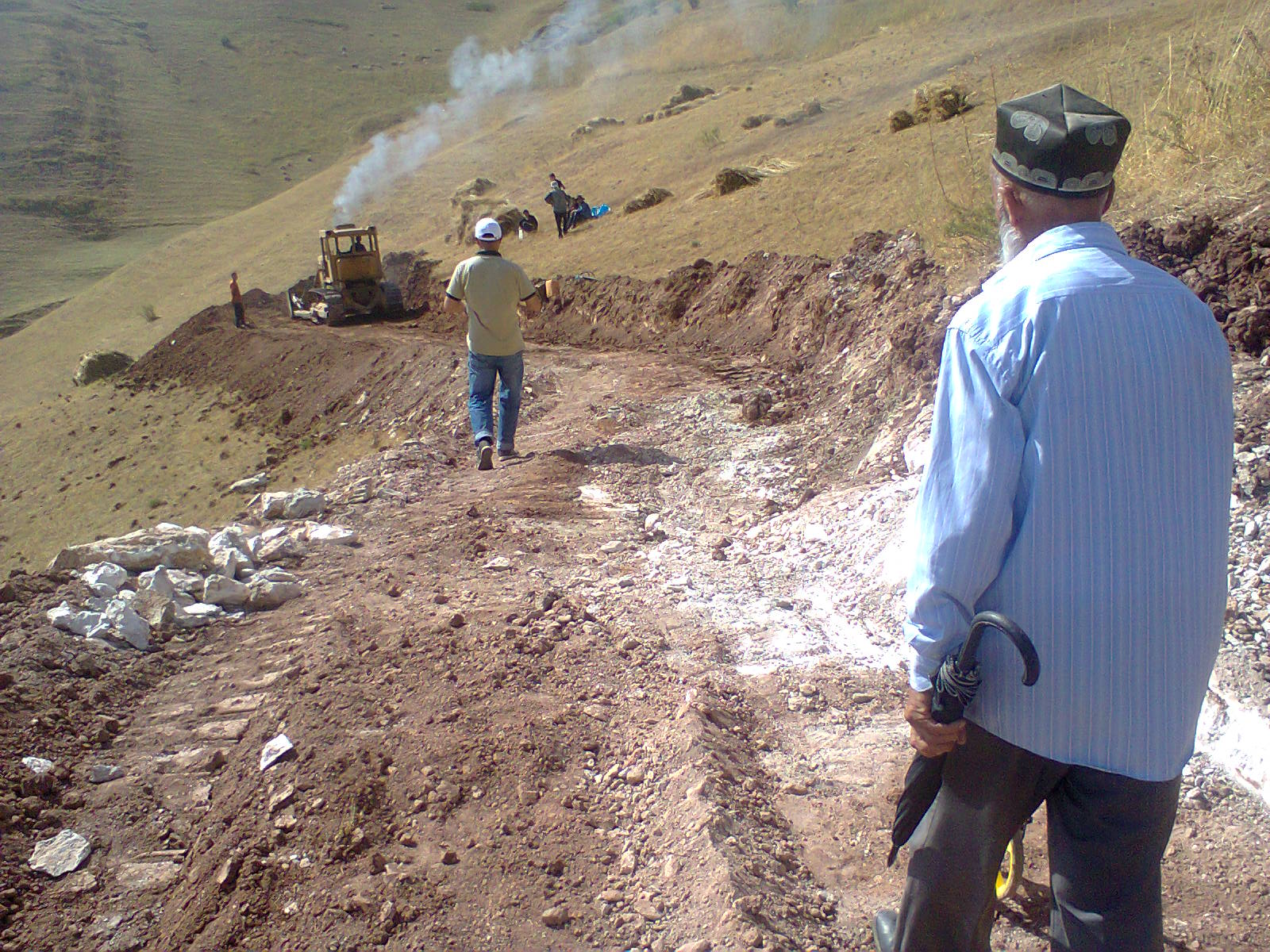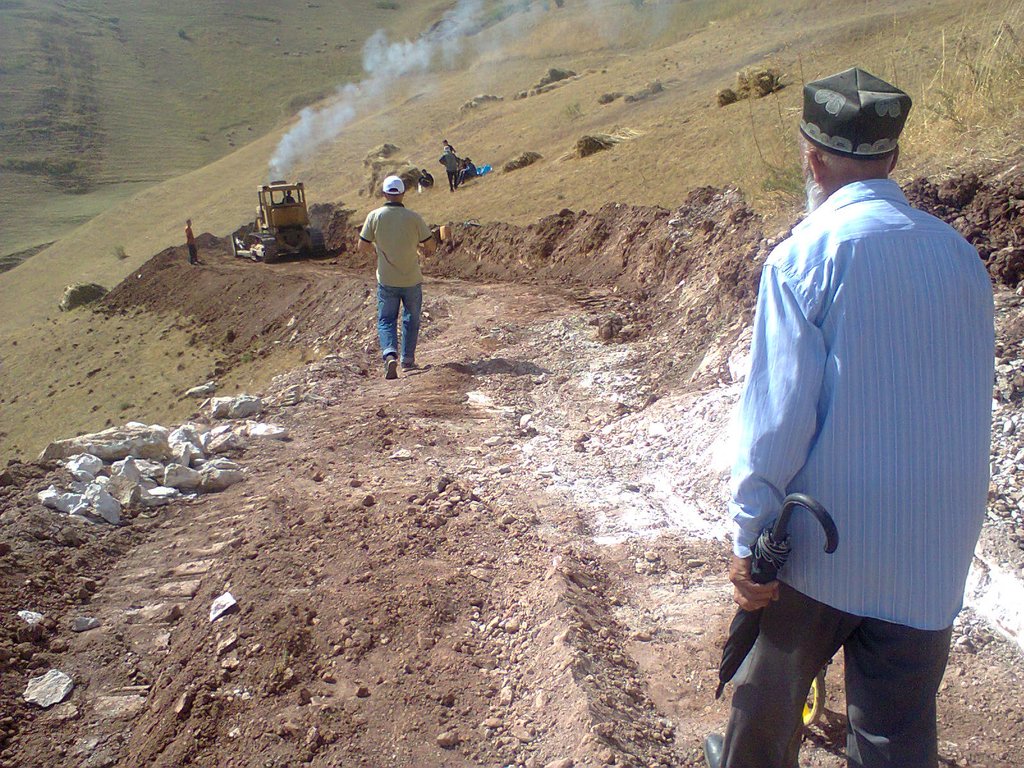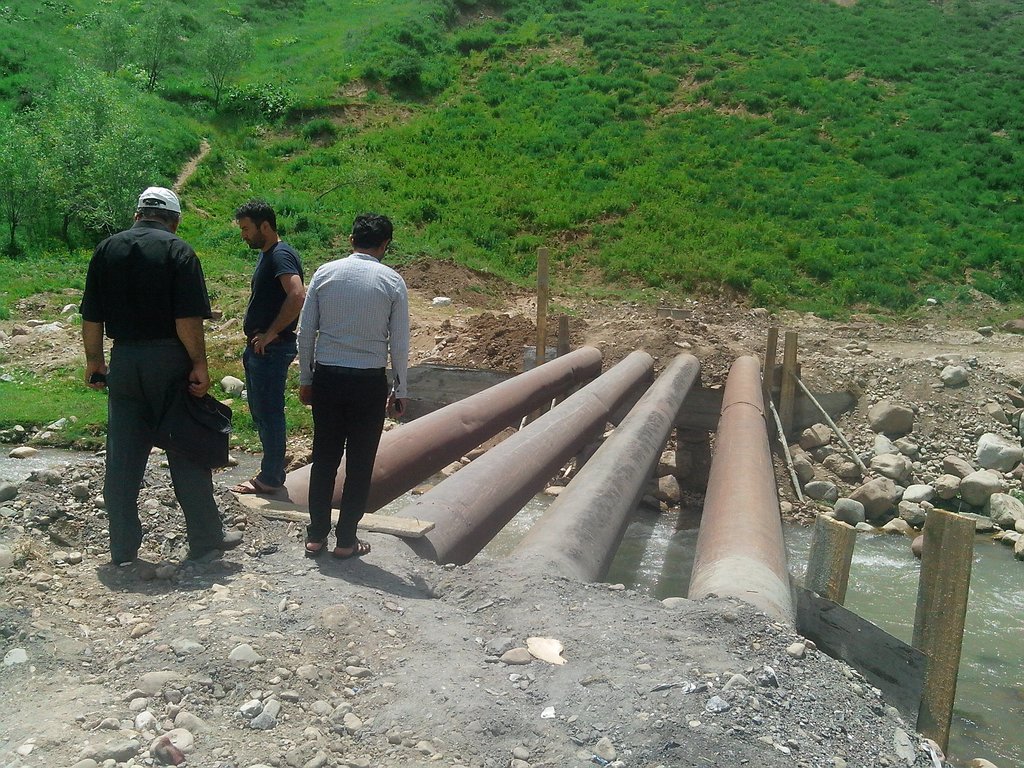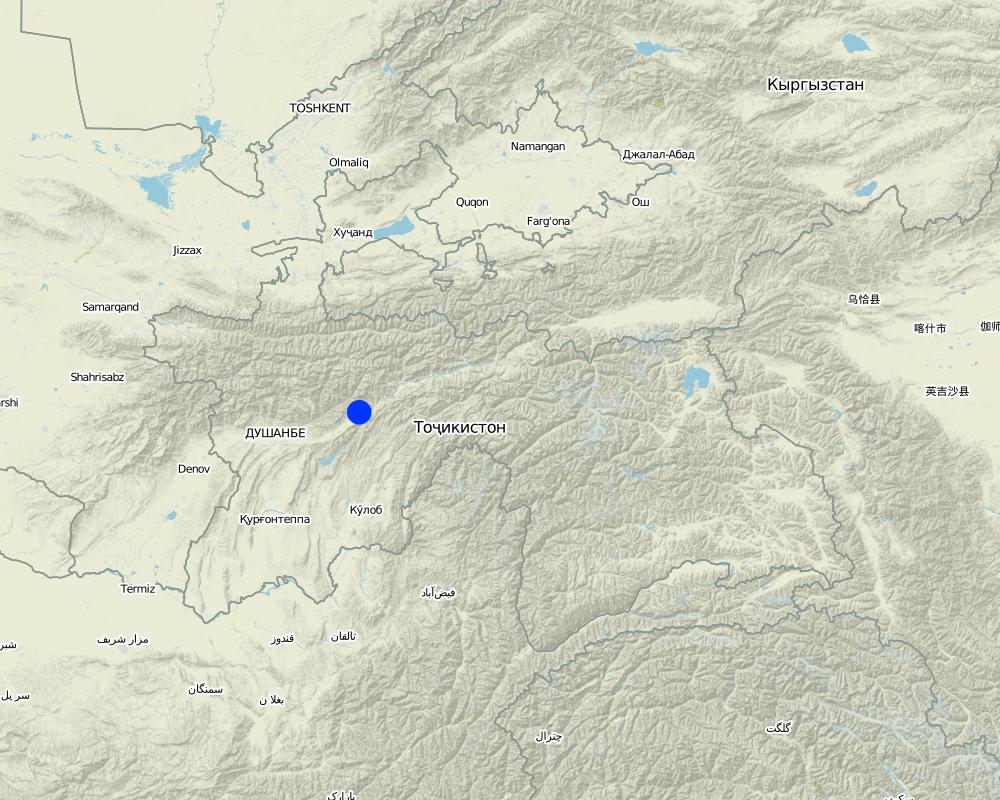Improved access to remote summer pasture - through infrastructure development [Tajikistan]
- Creation:
- Update:
- Compiler: Askarsho Zevarshoev
- Editor: –
- Reviewers: Maximilian Knoll, Yacime Khadraoui
Таъмини дастраси ба чарогохи тобистона
approaches_3467 - Tajikistan
View sections
Expand all Collapse all1. General information
1.2 Contact details of resource persons and institutions involved in the assessment and documentation of the Approach
Name of project which facilitated the documentation/ evaluation of the Approach (if relevant)
Environmental Land Management and Rural Livelihood Project1.3 Conditions regarding the use of data documented through WOCAT
When were the data compiled (in the field)?
20/09/2017
The compiler and key resource person(s) accept the conditions regarding the use of data documented through WOCAT:
Ja
2. Description of the SLM Approach
2.1 Short description of the Approach
In the mountainous conditions of Tajikistan the main source of fodder for livestock is accumulated in remote pastures, which are located high in the mountains and are classified as summer pastures. Improving access with building infrastructure (roads and bridges) to these remote pastures as a main source of fodder for livestock during summer period will decrease burden on pastures close to the village and will help rehabilitation of degraded pastures and improvement of other environmental services provided by pasture lands.
2.2 Detailed description of the Approach
Detailed description of the Approach:
The main feature in this approach is to balance the use of the pasture land in different seasons thorugh development of access to this resources. After the collapse of the Soviet Union and break down of the kolkhozes and Sovkhozes in the mountainous area of Tajikistan, utilization of pasture lands were suffering because of poor infrastructure, such as roads and bridges. Through community mobilization and sharing of funding costs such as labour force, roads and bridges providing access to remote pastures are build. This approach motivated communities to put in place rotation plans of patures. The main objective of promoting this approach is to organize the whole potential of existing fodder from the pasture and decrease burden on the close pasture lands to communities.
In this approach participatory methods was used, where community shared labour force and the local government support with formal documentation to allow contraction of new roads and bridges. Funding was mobilized from different sources, such as donor funds, governments and sometimes from the community itself.
Communities as members of PUUs were mobilized to serve as labour with some funding from project to access materials and means for implementation. The plan was negotiated and coordinated with the local level governmental authorities for legal permission both on improving infrastructure and use of pastures remote from villages.
Communities were excited to have access to additional pasture lands, as source of fodder for livestock development. Under this approach communities were motivated to plan pasture use in a sustainable way. Since the approach involves construction of roads and bridges, it involved a lot of manpower, especially during the agriculture season, where land users were also busy in their fields.
2.3 Photos of the Approach
General remarks regarding photos:
After constructing the small bridges, communities have access to more than 250ha additional pasture land, which they use seasonal. This easy access also minimized the risk of animal loss during crossing the river through the water.
2.5 Country/ region/ locations where the Approach has been applied
Country:
Tajikistan
Region/ State/ Province:
Roghun District/Rasht Valley
Further specification of location:
Usually this approach is applicable in many parts of the country which is mainly mountainous regions and a similiar geography.
Map
×2.6 Dates of initiation and termination of the Approach
If precise year is not known, indicate approximate date when the Approach was initiated:
less than 10 years ago (recently)
2.7 Type of Approach
- project/ programme based
2.8 Main aims/ objectives of the Approach
The main purpose of the approach is to support communities with improving access to the existing pasture resources and organize sustainable use of natural resources by providing also other ecosystem services such as recreational for people to go for hiking and mountaineering.
2.9 Conditions enabling or hindering implementation of the Technology/ Technologies applied under the Approach
social/ cultural/ religious norms and values
- enabling
Community and cultural norms are acceptable in coming together to work for community benefit for improving livelihood.
availability/ access to financial resources and services
- enabling
Traditionally, communities collect funds for such kind of social works for livelihood and village development.
- hindering
Sometime the big volume of the workload does not allow to contribute to such kind of big initiatives.
institutional setting
- enabling
Communities are traditionally organized to invest both financially and in kind in such community initiatives.
collaboration/ coordination of actors
- enabling
The approach brings all stakeholders together to work and make efforts for community development, where government is involved to mobilize communities.
legal framework (land tenure, land and water use rights)
- enabling
Usually, the pastures are owned by communities and considered as common resources used by all people. According to the Land Code, the government guarantees the effective use of natural resource for all people.
- hindering
It is allowed to own pasture by individuals and in some cases individuals have ownership over big areas of pasture resource, which limit community grazing in this area.
knowledge about SLM, access to technical support
- enabling
In this area PUUs have been established and the members were trained on different topics, including pasture management, land degradation with use of different methods.
- hindering
There is no official extention service on pasture management at community level and if there are any technical issues, the government refers to an official research institute, like the Livestock Institute, which has the capacity and knowledge to address specific topics.
workload, availability of manpower
- enabling
Traditionally, manpower is mobilized by communities to contribute to the project free of charge.
- hindering
Because of high level of migration provision of enough manpower through the community is difficult.
3. Participation and roles of stakeholders involved
3.1 Stakeholders involved in the Approach and their roles
- local land users/ local communities
livestock owners, PUU members, herders
usually serve as manpower and participate in the implementation of the approach
- community-based organizations
village organization, traditional groups
mobilize communities to contribute there share, negotiate with government in providing legal documentation for implementation of the approach
- NGO
registered local Public Organization
attracting donor organizations, support with development of the plan and mechanism for maintenance and sustainablity
- local government
land committee, agriculture department, environmental protection committee
provide legal documentation, supervise the compliance with norms and regulation of government
3.2 Involvement of local land users/ local communities in the different phases of the Approach
| Involvement of local land users/ local communities | Specify who was involved and describe activities | |
|---|---|---|
| initiation/ motivation | interactive | Community members such as livestock owners are involved in the process of identifying the potential for pasture development. |
| planning | interactive | Community members, who graze their livestock in the remote pastures together with community based organizations/structures jointly develop their plan and priorities they need. In their planning process a representative from the local government usually participates. |
| implementation | self-mobilization | In the implementation phase usually, if external funding is not available, community with support of their local structures organize themselves and share contribution to build or rehabilitate infrastructure to the pasture lands. |
| monitoring/ evaluation | interactive | If the project is funded from external resources joint monitoring is conducted with involvement of government representatives, funders and community members. |
3.4 Decision-making on the selection of SLM Technology/ Technologies
Specify who decided on the selection of the Technology/ Technologies to be implemented:
- mainly land users, supported by SLM specialists
Explain:
In their community planning process, either specific on pasture management or overall community planning, community members identify their needs and prioritise for implementation during a certain period. In this planning process a government representative usually participates aswell. Sometimes with support of I/NGOs specific planning tools or methodologies are developed and introduced at community level.
Specify on what basis decisions were made:
- personal experience and opinions (undocumented)
4. Technical support, capacity building, and knowledge management
4.1 Capacity building/ training
Was training provided to land users/ other stakeholders?
Nee
4.2 Advisory service
Do land users have access to an advisory service?
Nee
4.3 Institution strengthening (organizational development)
Have institutions been established or strengthened through the Approach?
- yes, a little
Specify the level(s) at which institutions have been strengthened or established:
- local
Describe institution, roles and responsibilities, members, etc.
Usually the community initiative is mobilized through community based organizations (village organization), which exist in all communities. In some cases specific structures, such as Pasture User Unions as separate entities or pasture user groups such as CBO sub-groups are established for proper management of pasture resources. In this case a pasture group with a specific working group (or brigade) consisting of specialized masters is organized to carry out the construction process and report to the official structure in the communities.
Specify type of support:
- financial
- equipment
Give further details:
for procurement of construction materials and fuel for tractor for road construction, fee for technical staff like engineer, masters
4.4 Monitoring and evaluation
Is monitoring and evaluation part of the Approach?
Ja
Comments:
compliance with sustainability plan and maintenance mechanism is monitored by the project staff and engineering work by technical staff was checked and readjusted
If yes, is this documentation intended to be used for monitoring and evaluation?
Ja
Comments:
internal documentation from the implementing agency is used t
4.5 Research
Was research part of the Approach?
Nee
5. Financing and external material support
5.1 Annual budget for the SLM component of the Approach
If precise annual budget is not known, indicate range:
- 10,000-100,000
Comments (e.g. main sources of funding/ major donors):
sharing contribution by donors and communities and also sometime by government
5.2 Financial/ material support provided to land users
Did land users receive financial/ material support for implementing the Technology/ Technologies?
Ja
If yes, specify type(s) of support, conditions, and provider(s):
construction materials and technical supervision with preparing of the design and implementation of the approach
5.3 Subsidies for specific inputs (including labour)
- equipment
| Specify which inputs were subsidised | To which extent | Specify subsidies |
|---|---|---|
| machinery | fully financed | tractor and bulldozer cost for working |
| partly financed | materials for fencing in some places, construction materials and pipes for bridge | |
- construction
| Specify which inputs were subsidised | To which extent | Specify subsidies |
|---|---|---|
| wood | partly financed | some was share by communities |
| cement | fully financed | based on the approved scheme, especially for construction of bridge the amount of cement is fully covered |
- infrastructure
| Specify which inputs were subsidised | To which extent | Specify subsidies |
|---|---|---|
| roads | partly financed | For construction/rehabilitation of roads usually only materials and tools (construction machinery) are provided. The job is carried out by communities as there contribution. |
If labour by land users was a substantial input, was it:
- voluntary
Comments:
labour usually in construction project is considered as community contribution, which is organized by the community based organization and agreed on the pre-planning session of the project selection process
5.4 Credit
Was credit provided under the Approach for SLM activities?
Nee
5.5 Other incentives or instruments
Were other incentives or instruments used to promote implementation of SLM Technologies?
Nee
6. Impact analysis and concluding statements
6.1 Impacts of the Approach
Did the Approach empower local land users, improve stakeholder participation?
- No
- Yes, little
- Yes, moderately
- Yes, greatly
The project brings together different stakeholders who are interested in sustainable management and use of pastures, such as livestock owners, local government agencies, community based organizations.
Did the Approach help land users to implement and maintain SLM Technologies?
- No
- Yes, little
- Yes, moderately
- Yes, greatly
When access to new pastures improve, different other approaches and technologies are applied in this new area.
Did the Approach mobilize/ improve access to financial resources for SLM implementation?
- No
- Yes, little
- Yes, moderately
- Yes, greatly
When communities make their own plan to implement projects for their livelihoods, (especially construction) either government, local businessmen and external resources are interested to contribute.
Did the Approach mitigate conflicts?
- No
- Yes, little
- Yes, moderately
- Yes, greatly
To some extent, when approaches improve access to new areas, pressure over pastures will be decreased.
Did the Approach improve issues of land tenure/ user rights that hindered implementation of SLM Technologies?
- No
- Yes, little
- Yes, moderately
- Yes, greatly
Communities will have access to new or unused pasture lands and will strengthen ownership over this resources.
Did the Approach lead to improved food security/ improved nutrition?
- No
- Yes, little
- Yes, moderately
- Yes, greatly
When a new source of fodder is established, livestock productivity will improve and contribute to community food security and nutrition.
6.2 Main motivation of land users to implement SLM
- increased profit(ability), improved cost-benefit-ratio
When access to new pasture land is provided, communities will have also a chance to collect more fodder and keep their livestock in a better condition.
- reduced land degradation
Burden and pressure to the close pasture decreased and they slowly started rehabilitating.
- reduced risk of disasters
Degradation of the pasture is the main cause of landslide and mudflow in the mountain areas. When close pasture degradation is improved, this will also mitigate the risk of landslide and mud flow.
- payments/ subsidies
Usually communities are organized in their community based organization, which develops their own plan, based on what prioritized initiatives will be implemented by their efforts. Sometimes, when external funding subsidieses these costs, it motivates community members to participate actively.
6.3 Sustainability of Approach activities
Can the land users sustain what has been implemented through the Approach (without external support)?
- uncertain
If no or uncertain, specify and comment:
If the approach is applied properly and the rotation grazing is followed, the infrastructure is maintained, then it contributes to the sustainability of the project. Usually communities collect money when rehabilitation is required.
6.4 Strengths/ advantages of the Approach
| Strengths/ advantages/ opportunities in the land user’s view |
|---|
| provide them with additional pasture areas, give them opportunity to improve their pasture resource conditions. |
| Strengths/ advantages/ opportunities in the compiler’s or other key resource person’s view |
|---|
| The approach motivates community to share resources for the community work and contribute voluntary lobour. |
6.5 Weaknesses/ disadvantages of the Approach and ways of overcoming them
| Weaknesses/ disadvantages/ risks in the land user’s view | How can they be overcome? |
|---|---|
| It is difficult to fund big projects, because infrastructure development to access new pasture areas is always associated with big funding. | establish special fund for maintenance of this approach |
| Weaknesses/ disadvantages/ risks in the compiler’s or other key resource person’s view | How can they be overcome? |
|---|---|
| Community structures are new and are not well empowered to maintain all the innovative approaches. | empower PUU and pasture users to become the real owner of the resource and build their capacity in management of their structure and sustainability |
7. References and links
7.1 Methods/ sources of information
- field visits, field surveys
8-15
- interviews with land users
8
- interviews with SLM specialists/ experts
2
- compilation from reports and other existing documentation
2
7.2 References to available publications
Title, author, year, ISBN:
Pasture and Livestock Management Plan, Zevarshoev Askarsho, 2015
Available from where? Costs?
available upon request
Links and modules
Expand all Collapse allLinks
No links
Modules
No modules





